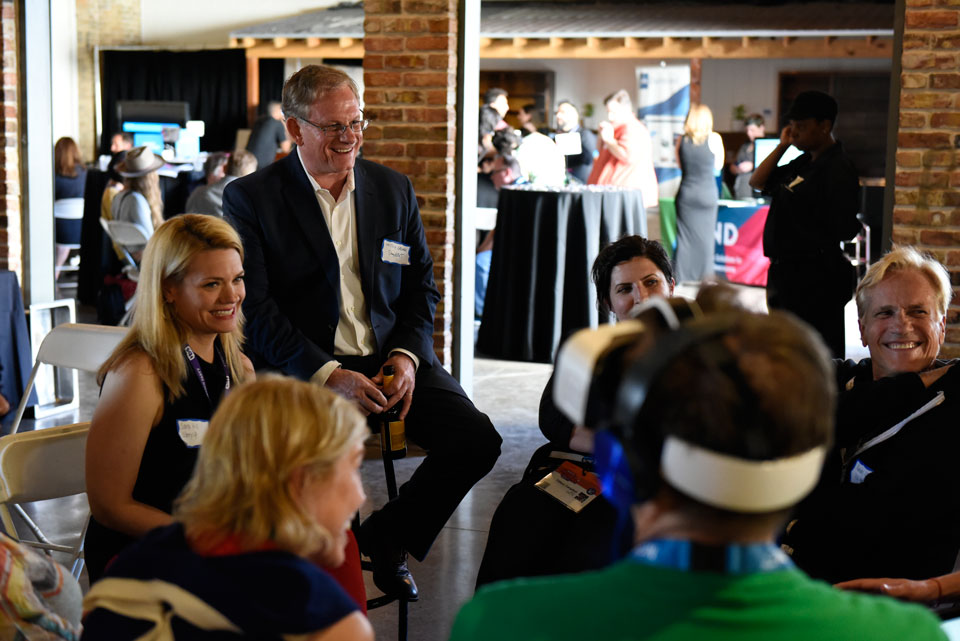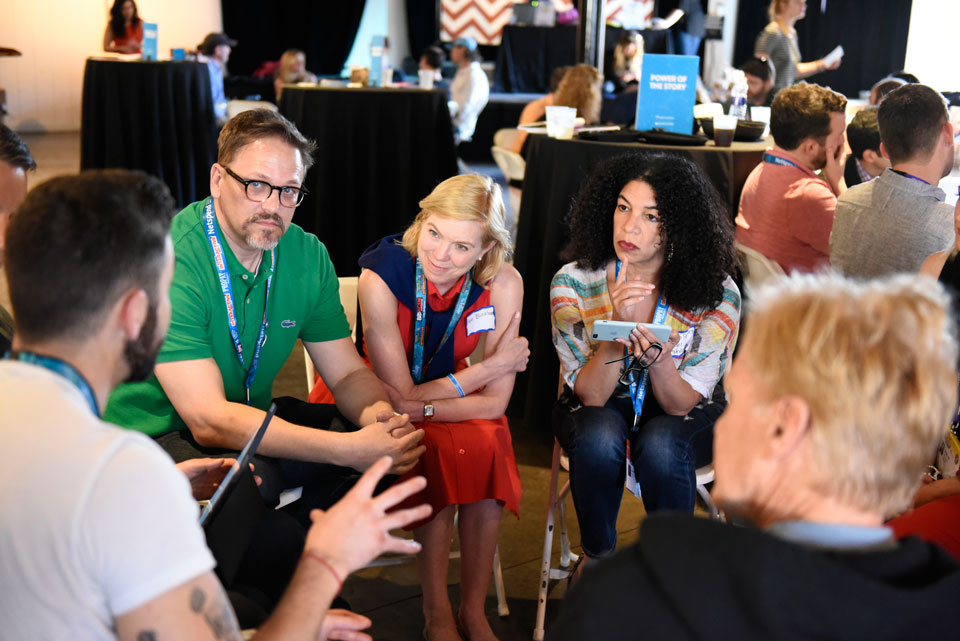
Knight gathers journalists, technologists and filmmakers at SXSW to explore trends and opportunities in virtual reality
Above: Virtual Reality Journalism discussion at SXSW in Austin. Credit Jesse J. Loesch.

PBS Frontline Executive Producer Raney Aronson Rath (holding mic) discusses VR Journalism at SXSW. Also, left to right, Randal Kleiser; Mitch Gelman, USA TODAY NETWORK (in gray); Molly Swenson, RYOT (with hat); Jamie Pallot, Emblematic Group (in jeans). Credit Jesse J. Loesch
What is the best way for journalists to immerse audiences in virtual reality? How do they preserve a narrative thread into the scenes they are creating? Can the use of virtual reality provide misleading experiences?
These were just a few of the questions explored during a convening of more than 50 journalists, technologists and filmmakers for a virtual reality and journalism meetup at SXSW Interactive on Sunday sponsored by Knight Foundation and StoryNEXT.
As immersive storytelling develops, Knight is gathering research and best practices from the field, while bringing leaders together to share their experiences and explore trends.
The latest findings show that journalism could be a key factor in the evolving medium’s success, according to a report from Knight and USA TODAY NETWORK, titled “Viewing the Future? Virtual Reality in Journalism” that was released during Sunday’s event.
Companies have invested billions of dollars in the upcoming release of headsets and other ways that will make virtual reality experiences more widely accessible to consumers. News organizations in the vanguard of the trend realize that the development of high-quality journalism may be essential in determining the medium’s value to everyday users and its ultimate success.

Photo: Sara Hill, chief storyteller, @StoryUpStudios and Mitch Gelman, USA TODAY NETWORK/Gannett digital VP/product and Randal Kleiser lead a group viewing an episode of Kleiser’s VR project titled “Defrost” at SXSW in Austin. Photo by Jesse J. Loesch.
“In order for people to reach into their wallets to purchase the new VR viewing systems, the content has to be great,” said Mitch Gelman, who led the development of experiential news coverage for the USA TODAY NETWORK and organized the event with Knight Foundation. “Once the initial novelty of VR wears off, the key to getting an audience to come back will be storytelling that takes full advantage of the power of the immersive technology. There is a lot at stake.”
According to the report, the number of investors in virtual reality hardware and software increased more than 27 percent from 2014 to 2015 and is expected to continue to grow in 2016. Sam Gill, Knight’s vice president for learning and impact, co-authored the report with Gelman and journalist Patrick Doyle.
The report also charts the flurry of experimentation in the last year by news organizations such as the Emblematic Group, “Frontline,” Fusion, The New York Times, Fusion, USA TODAY NETWORK, The Wall Street Journal and The Washington Post.
While these early efforts are producing more immersive stories, they are also generating questions, including new ethical considerations around issues such as what is news and what is entertainment.
“We are happy to walk a fine line while applying the highest journalistic standards,” said Raney Aronson, executive producer of “Frontline,” noting, for example, that she would “not use actors in a journalistic documentary.”
Aronson led a discussion session during the meetup with James Pallot, who runs the Emblematic Group with Nonny de La Peña, often described as the godmother of virtual reality journalism, which has accelerated in just four years. In 2012, de la Peña debuted the immersive story “Hunger in Los Angeles” at the Sundance Film Festival, using makeshift goggles put together by Palmer Luckey, a 19-year-old journalism intern. Luckey went on to co-found the virtual reality company Oculus VR, which Facebook bought in 2014 for $2 billion.
To support the creation of best practices for the industry, last year Knight Foundation awarded $580,000 in funding to “Frontline” and the Emblematic Group to jointly produce at least three virtual reality experiences. Knight also sponsored the StoryNEXT conference at the New York Television Festival last fall as part of this effort to support the advancement of journalism in the digital age.

Left to right: Scott Williams, COO, SVP Sales & Marketing, Newseum; Ann Blinkhorn, Blinkhorn Executive Recruiting; Karen Rundlet, Knight Foundation. Photo by Jesse J. Loesch.
At the SXSW event, other leaders attending included Fusion’s Jigar Mehta; Jeremy Gilbert of The Washington Post; Ben Nunez, CEO of the Littlstar platform; Gannett Digital’s Niko Chauls; Shazna Nessa, Knight’s director of journalism; RYOT’s Molly Swenson; Rosental Alves and R.B. Brenner from the University of Texas at Austin; Jeffrey Herbst, president of the Newseum; and Linc Gasking, whose company 8i delivers high-end motion capture for walk-around VR experiences.
They applied interdisciplinary thinking to the storytelling challenges as they debated the ethical considerations raised by shooting 360-degree spherical video, shared ideas on how to establish a narrative flow in virtual reality and probed whether new sources of revenue can sustain the cost of production.
“I’ve been waiting 25 years for this,” said Chris Pfaff, a consultant and one of the founders of the Producers Guild of America New Media Council East, referring to his first work on a virtual reality project at Bell Labs. “We have broken down the cost barriers. We have low-cost viewers. We have low-cost digital cameras. “
Pfaff said he saw huge opportunity with the expected consumer demand. “Some of the real groundbreaking work that is being done in VR storytelling is coming from journalists and journalism organizations,” he said. “It is great to be a part of a session of storytellers who are actually examining how to tell stories in VR. Are you honest with the audience on how you use the space? Are you there to enhance the story or just dazzle them?”
Join the conversation. What are your questions about virtual reality and the role of journalism? Read “Viewing the Future? Virtual Reality in Journalism”and add your comments. Jennifer Preston is vice president for journalism at Knight Foundation. Email her via preston@knightfoundation and follow her on Twitter @jenniferpreston.
Recent Content
-
Journalismarticle ·
-
Journalismarticle ·
-
Journalismarticle ·


